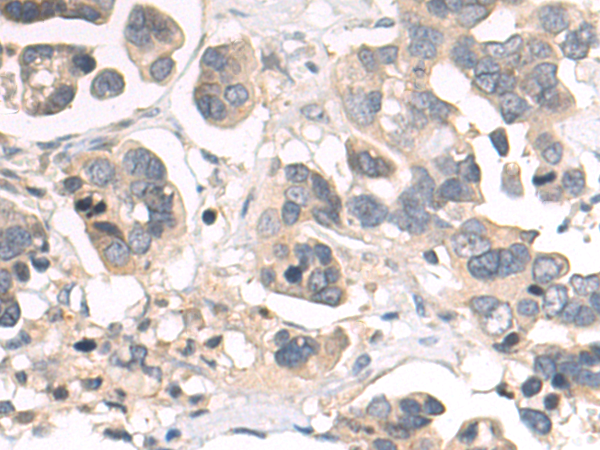
| WB | 咨询技术 | Human,Mouse,Rat |
| IF | 咨询技术 | Human,Mouse,Rat |
| IHC | 1/50-1/200 | Human,Mouse,Rat |
| ICC | 技术咨询 | Human,Mouse,Rat |
| FCM | 咨询技术 | Human,Mouse,Rat |
| Elisa | 1/1000-1/5000 | Human,Mouse,Rat |
| Aliases | MEH; EPHX; EPOX; HYL1 |
| Host/Isotype | Rabbit IgG |
| Antibody Type | Primary antibody |
| Storage | Store at 4°C short term. Aliquot and store at -20°C long term. Avoid freeze/thaw cycles. |
| Species Reactivity | Human, Mouse, Rat |
| Immunogen | Fusion protein of human EPHX1 |
| Formulation | Purified antibody in PBS with 0.05% sodium azide and 50% glycerol. |
+ +
以下是3篇与APLNR(Apelin受体)抗体相关的文献摘要信息:
---
1. **文献名称**: *"Targeting APJ receptor with novel antibodies for anti-angiogenic therapy in solid tumors"*
**作者**: Zhang Y, et al.
**摘要**: 该研究开发了针对APJ受体(APLNR)的单克隆抗体,验证其在体外和体内抑制肿瘤血管生成的能力,证明其通过阻断Apelin/APJ信号通路显著降低小鼠模型中肿瘤的生长和转移。
---
2. **文献名称**: *"A neutralizing antibody against apelin receptor reduces cardiac hypertrophy and fibrosis in pressure overload models"*
**作者**: Sato T, et al.
**摘要**: 研究团队设计了一种中和性抗体,通过特异性结合APJ受体胞外域,抑制病理性心肌肥厚和纤维化。实验显示,该抗体可减轻压力超负荷小鼠模型的心脏重塑,提示其治疗心力衰竭的潜力。
---
3. **文献名称**: *"APJ receptor antibodies as biomarkers in pulmonary arterial hypertension"*
**作者**: Kim J, et al.
**摘要**: 本文探讨了APJ受体自身抗体在肺动脉高压(PAH)患者中的表达水平,发现其与疾病严重程度相关,并提出了该抗体可能作为PAH诊断和预后评估的新型生物标志物。
---
如需更详细的文献信息或具体实验数据,建议通过PubMed或Web of Science平台进一步检索。
The APLNR (Apelin Receptor) antibody is a research tool targeting the apelin receptor, a class A G protein-coupled receptor (GPCR) encoded by the APLNR gene. This receptor binds apelin and its endogenous ligand, ELABELA, playing critical roles in cardiovascular development, angiogenesis, fluid homeostasis, and metabolic regulation. It activates multiple signaling pathways, including Gαi/o, β-arrestin, and MAPK/ERK, influencing vasodilation, cardiac contractility, and insulin sensitivity. Dysregulation of the apelin-APLNR axis is linked to conditions like hypertension, heart failure, diabetes, and cancer.
APLNR antibodies are widely used in biomedical research to study receptor expression, localization, and function in tissues. They enable techniques like immunohistochemistry, Western blotting, and flow cytometry, helping to map APLNR distribution in endothelial cells, cardiomyocytes, and tumor microenvironments. Some therapeutic antibodies are under exploration to modulate APLNR activity—agonists for cardiovascular repair or antagonists to inhibit pathological angiogenesis in cancers. Challenges include ensuring receptor subtype specificity and minimizing off-target effects due to GPCR structural homology. Recent studies also highlight APLNR's role in COVID-19-related vascular damage, expanding its clinical relevance. These antibodies remain vital for deciphering APLNR's dual roles in physiology and disease, offering potential diagnostic and therapeutic avenues.
×